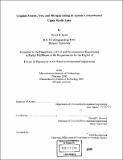Coupled arsenic, iron, and nitrogen cycling in arsenic-contaminated Upper Mystic Lake
Author(s)
Senn, David B. (David Bryan), 1970-
DownloadFull printable version (19.21Mb)
Alternative title
UML, Winchester, MA
Other Contributors
Massachusetts Institute of Technology. Dept. of Civil and Environmental Engineering.
Advisor
Harold F. Hemond.
Terms of use
Metadata
Show full item recordAbstract
This dissertation addresses the mechanisms controlling arsenic (As) remobilization and cycling in the hypolimnion of As-contaminated Upper Mystic Lake (UML; Winchester, MA). We conducted field and laboratory studies, and applied mass balance, surface complexation, and thermodynamic modeling to explore As cycling and its links to other elemental cycles (Fe, N, 02) in UML. Nitrate appears to control iron (Fe) and As cycling in the hypolimion of urban, eutrophic UML. In doing so, nitrate assumes the role typically taken by oxygen in the cycling of redoxactive metal(loid)s. High nitrate and ammonium inputs, combined with authigenic nitrate production in the water column (nitrification, consuming 40% of hypolimnetic oxygen), result in several months per year of anoxic, yet nitrate-rich conditions in the hypolimnion. As expected, the onset of anoxia triggers Fe and As remobilization from UML's contaminated sediments. However, despite anoxia, remobilized Fe and As accumulate in the water column primarily in their oxidized forms (Fe(IlI)-oxides and As(V)). Mass balance estimates indicate that nitrate is responsible for oxidizing the majority of the iron, which must initially have been remobilized by reductive dissolution as Fe(II). Microcosm studies confirmed this reaction's feasibility: anaerobic, biologically mediated Fe(II) oxidation occurred in nitrate-spiked microcosms with sample obtained from the sediment-water interface. Shifts in As and Fe redox chemistry toward their reduced forms (Fe(II) and As(III)) were correlated temporally and spatially with nitrate depletion. Nitrate's presence therefore appears to favor arsenic's accumulation as particle-reactive As(V) , either by directly oxidizing remobilized As(III) or indirectly by serving as a more energy-rich electron acceptor and forestalling As(V) reduction to As(III). During nitrate-rich periods, greater than 85% of remobilized arsenic was found to be particle complexed (deff > 0.05 [mu]m) at representative hypolimnetic depths by in situ filtration. Surface complexation modeling of As on Fe(III)-oxides accurately predicts As distribution between particle-complexed and dissolved phases. Thus Fe(III)-oxides appear to scavenge the vast majority of remobilized As. Through the anaerobic production of particulate Fe(III)-oxides, and by indirectly or directly causing As to accumulate as particle-reactive As(V), nitrate dominates remobilized As chemistry, and provides a continued As sink (via settling) during a large portion of anoxic periods.
Description
Thesis (Ph.D.)--Massachusetts Institute of Technology, Dept. of Civil and Environmental Engineering, 2001. Includes bibliographical references (p. 253-265).
Date issued
2001Department
Massachusetts Institute of Technology. Department of Civil and Environmental EngineeringPublisher
Massachusetts Institute of Technology
Keywords
Civil and Environmental Engineering.